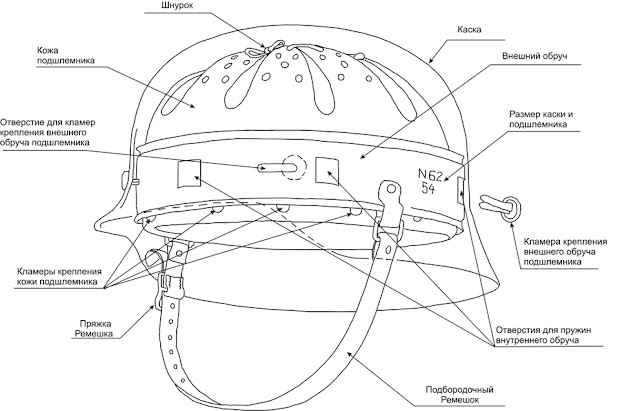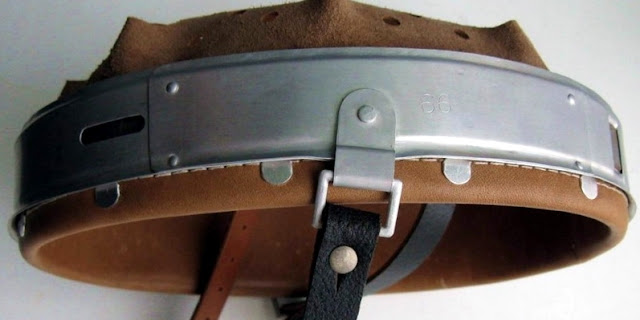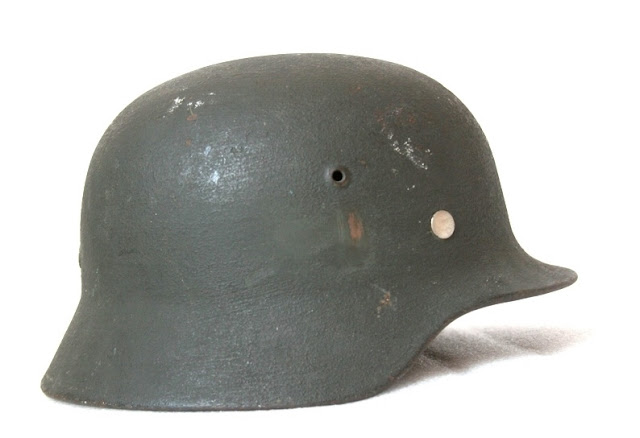After WWI, the role of infantry changed. Trench warfare was left behind, mobility increased, and new requirements were demanded of the infantry helmet. This resulted in the development of a new generation of the Stahlhelm, which, in general, inherited the shape of its predecessors.
Liner model 1931
A large number of helmets produced during WWI were destroyed under the conditions set by the Treaty of Versailles, but the German Reichswehr still had a large variety of helmets in use. During their use, the helmet liners wore out and required either repair or replacement. The issue of developing a new unified helmet liner was raised.
On November 14th, 1934, the Directorate of Armament and Supply of the German army decided to replace all helmet liners of M16, M17, and M18 helmets currently in use with a new unified liner, named helmet liner model 1931 (Innenausstatung 31, М1931). This type of liner was developed and patented by Schuberth-Werke Braunschweig.
Helmet liner model 1931 installed in a helmet.
Initially, a small batch of helmet liners was produced for trials, which were held in 1931-1934. As a result of the trials, it was decided that the model 1931 helmet liner would be adopted as a unified liner to replace all formerly installed liners and to be installed in new production helmets.
The official adoption of the M1931 liner coincided with the testing of the experimental M35 helmet, which was designed to use this liner. A decision to give contracts to produce this helmet liner to other companies, not just Schuberth-Werke, was made in 1938, at the same time mass production of the M35 begna.
Helmet liners produced between 1931 and 1934 had a marking that read "1931", referring to the model. Starting with 1935, the marking changed to reflect the actual year of manufacture.
Model 1931 helmet liner.
The liner remained in use until May of 1945, with two slight modifications.
The model 1931 liner was complex, and significantly different from earlier designs. The design took into account the shape of the head, so individual adjustment was needed. Each soldier had his head measured and a corresponding liner picked, which in turn set the size of the helmet that he would receive. Two sizes of liners could be installed in each size of helmet.
Each ring of the helmet liner had a stamp, indicating the size of the liner in centimeters. The external ring, which was attached to the helmet, had a stamp of the manufacturer on one side and the size of the helmet and liner on the other. The latter stamp was composed of either two lines, separated by a line, or one, separated by a /. The stamp contained the letters "n.A.", which stood for neues Art, "new design".
Markings on the external ring. Sizes (above) and manufacturers (below).
On one hand, this approach made the helmet easier to wear, on the other hand, this meant that it was not easy to replace. A soldier that mixed up his helmet with someone else's would not be able to use it, since the liner would not fit him. Field repairs of helmets were also complicated by this.
The design of the model 1931 helmet liner consisted of two concentric rings made from metallic bands, attached together with leaf springs.
Diagram of the model 1931 helmet liner.
The outer ring had stamped openings for attaching the liner to the helmet. The shape of the openings was dictated by the fact that M16, M17, and M18 helmet liners could have different locations of these openings due to production issues. The three openings were more or less evenly spaced out along the ring.
Openings for attaching the helmet: side (left) and rear (right).
In addition to these openings, the outer rim had five eyes for hooking springs that held the inner rim. Metallic D-shaped clasps for the chin strap were also attached to the outer rim using rivets.
The inner rim was attached to the outer one by means of five leaf springs with rounded edges. The springs were attached in the center by rivets to the inner rim. They were then inserted into slits on the outer rim, with two neighbouring springs sharing each slit. The springs were either painted or primed to prevent corrosion. All metallic components of the liner were produced from aluminium or an alloy.
Clasps that hold the liner to the helmet (left) and affix the leather part of the liner (right).
The leather part of the liner was held onto the inner rim using 12-13 aluminium clasps. This part consisted of a leather strip with petals that were drawn together with a leather lace. Each petal had five ventilation openings in it and one for the lace.
To prevent the leather from rubbing through or stretching, a strip of felt was sewn into the inside of the liner. The number of petals varied from 7 to 9, depending on the size. Samples with split petals have also been found. The leather parts were made of pig leather by subcontractors and supplied to the helmet manufacturer for final assembly. The leather part bore an ink stamp that indicated the size and sometimes the manufacturer.
A felt strip on the leather part of the liner.
The first modification to the model 1931 liner was proposed on January 20th, 1938, when Werner Zahn Berlin obtained a patent for the improved model. An order from the army followed on February 8th, 1938.
The modification was necessary to due drawbacks of the design that have been uncovered during service. After the M35 was adopted, the Wehrmacht and Luftwaffe complained that the outer rim of the helmet liner easily deformed around the chin strap rivets. This either resulted in the rivet falling out or the liner bending. This happened when soldiers hung up their helmets by the chin strap during a march.
The modification consisted of reinforcement of the outer rim by means of riveting a metallic reinforcement strip in the place where the rivet was attached. This reinforced the outer rim and the whole liner. The outer rim markings (manufacturer and size) migrated to these strips. All manufacturers introduced this variant in 1938, with the exception of Max Densow Berlin Kofferfabrik, which continued to produce the original liner.
A modernized model 1931 liner.
A second change to the model 1931 design was introduced in 1940. The metallic parts of the liner were now produced from zinc plated steel. The D-shaped clasps of the chin strap also changed. The sharp corners were evened out.
Helmet liners produced with steel parts were tougher, and there was no need to add reinforcement strips. The same parts were used as before, but from a different material. Some companies continued to use leftover components, and there are helmets with both steel and aluminium parts.
At the same time as the second variant entered production, the M35 helmet was modernized. M40 and M42 helmets also used M1931 liners with steel parts.
Most companies completed production of aluminium part liners by the end of 1940, but Werner Zahn used aluminium parts until 1943. Due to a large amount of aluminium liners produced, M40 helmets produced in 1940 and 1941 still used them.
A chin strap.
The chin strap for the M1931 liner entered production on November 22nd, 1935. It had a complex buckle cast from various materials (brass, aluminium, steel), a simpler method of attachment to the liner, and could easily be transferred from one helmet to another. The strap was made from leather. It could be used with other types of liners or reversed for left handed soldiers.
Model 1935 steel helmet
Trials of a new helmet, based on the ones used in WWI, began in 1934. The overall shape of the helmet was similar, but it became smoother. The development was headed by Friedrich Schwerd, who also took part in the design of the M16. Production of prototypes and preparations for mass production were done at the Eisenhuttenwerke factory in Thale.
Stahlhelm model 1935.
Supreme Command officially accepted the model 1935 steel helmet into service under the name "steel helmet model 1935", M1935, or M35. The design of the M35 was similar to that of the M16, but had a shorter rim and visor, as well as different ventilation openings. It was also significantly lighter.
The ventilation openings of the M35 were built from individual rivets with a n opening in the middle, while the M16, M17, and M18 had screw-in plugs. There were only two ventilation openings in the M35, and they were used only for ventilation, not for carrying forehead armour.
The M35 used the model 1931 helmet liner with a new type of strap. Three openings were made in the helmet to carry the helmet liner: two near the ventilation openings, above the visor line, and one in the rear.
The helmet was made by stamping. The alloy used was carbon-molybdenum steel. The thickness of the helmet was 1-1.5 mm. A helmet made from this steel could withstand pressure up to 220 kg/cm², which allowed it to resist large shell fragments and pistol bullets.
The process of production consisted of several stages: cutting the steel sheet, stamping the dome on a press, expansion of the rim, drilling the openings for attaching the helmet liner and ventilation openings, and installing the ventilation opening rivets.
The M35 was produced in seven sizes: 60, 62, 64, 66, 68, 70, and 72. The size of the helmet was measured as the circumference of the inside at the level of the helmet liner openings. One helmet could fit two different sizes of liner. For instance, a size 60 helmet could fit a size 52 or 53 liner.
Manufacturer stamps on the helmet.
60, 68, 70, and 72 sized helmets made up about 10% of the total production, since there were few soldiers with heads of that size. 70 and 72 size helmets were made in very small batches.
One company could not cope with producing a large amount of helmets, and orders were placed at a number of factories. There were seven main producers of the M35 helmet in Germany, all in different cities.
- Emaillierwerke A.G, Fulda. These helmets were marked EF.
- Eisenhuettenwerke Thale. These helmets were marked ET, after 1942 - CKL.
- Schsische Emaillier und Stanzwerke Lauter. Initial production was marked SE, later HKP.
- Vereinigte Deutsche Nikelwerke Schwerte. Initial production was marked DP, later NS.
- Quist Esslingen. These helmets were marked with the letter Q.
- Karl Heisler Berlin. These helmets were marked QVL.
- Bergmann & Co. Th. Abt. Automaten- und Metallwarenfabrikation Hamburg – Altona. These helmets were marked BVL.
These companies were entirely independent, which introduced some differences into their products. The markings consisted of the factory mark, size of helmet, and production batch. Initially, the stamp was placed near the right ear, and the batch number was placed in the rear. Later, all markings were moved to the rear.
Ink stamps.
In addition to these stamps, an ink stamp was placed inside the helmet to indicate the month and year that the helmet was purchased by the German army. There are various different formats with different text inside the stamp.
The M35 was used throughout WWII, and many were used after it ended. 1.4 million M35 helmets of all sizes were produced in the first two years of its production, and about a million more before the production process changed in 1940.
Model 1940 helmet
Modifications of the M35 were proposed almost immediately after it entered production. Eisenhuettenwerke engineers were tasked with this work.
Molybdenum used in the steel alloy made it tough, but brittle. Its use after 1938 was also limited due to the high price and the fact that nearly 90% of all molybdenum acme from the USA and South America.
Ventilation opening rivets. M35 (left) and M40 (right).
A modification of the M35 was patented on October 29th, 1938, by Erich Kisan, who worked at the Eisenhuettenwerke factory in Thale. The improvement consisted of stamping ventilation openings with the helmet instead of drilling and riveting them. The ventilation opening was now surrounded by a small bump outside of the helmet. This allowed steel to be saved and improved the protection of the soldier's head. If the helmet was damaged, a loose rivet could result in additional wounds.
In addition to the new ventilation openings, the M40 was made of different steel, hardened with manganese silicate instead of expensive molybdenum.
The modernized model 1931 helmet liner with zinc or oxide plated steel parts was installed in the M40. It was cheaper and more practical than the aluminium version. The M40 was identical to the M35 in other respects. Overall, it was a little heavier.
The rim of the M35 and M40 helmets was identical.
The M40 gradually replaced the M35 in service, although the M35 continued to be used until the end of the war. Helmet liners made with aluminium parts were installed on M40 helmets until they ran out. The M40 was built in the same sizes as the M35.
Model 1942 steel helmet
Preparations for the last type of helmet produced during the war began on April 20th, 1942. This variant aimed at maximally simplifying production and reducing cost. The rim changed compared to the M35 and M40. This was supposed to reduce the number of steps involved in production. This helmet was called "steel helmet model 1942", M1942, or M42.
Simplified rim of the M42.
The first M42 helmets were produced on August 1st, 1942. The M42 differed from the M40 only in the shape of the rim, which was no longer bent inwards, but left nearly unaltered after the stamping. Another difference, unnoticeable to the naked eye, was the composition of the steel. It was no longer hardened at all. Overall, production of the helmet became easier and cheaper, but this had an effect on the quality of the product.
The sizes of the M42 helmets were the same as the M35 and M40. The helmet liner was the same as the one used in the M40.
The M42 remained in production until late 1944-early 1945, when most factories producing components for them were captured by the Allies or abandoned due to a lack of materials. The M42 was used until the end of the war alongside the M35 and M40, gradually replacing them.














